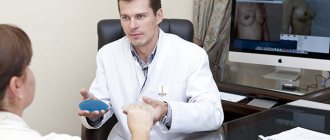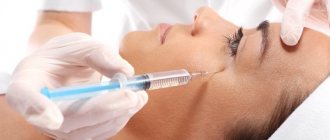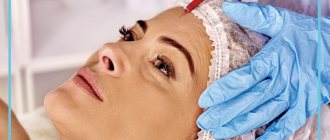Mammoplasty or breast surgery is one of the most popular and sought after operations.
- Why complications arise
- Types of complications Swelling of the chest or abdomen
- Seromas and hematomas
- Increased body temperature and inflammation
- Pain after mammoplasty
- Keloid scars
- Loss of skin sensitivity
- Capsular contracture
- Damage to the implant
- Breast deformities and their unnatural appearance
Every year, many women come to surgeons wanting to make their bust bigger. Intervention techniques, as well as the implants used, are constantly being improved. However, mammoplasty remains a full-fledged operation, after which, theoretically, complications may arise, especially if the patient ignores the recommendations of doctors during the rehabilitation period.
Causes of complications after mammoplasty
We will discuss the possible unpleasant consequences of surgical breast augmentation and methods for correcting them in the second part of the material, since from a practical point of view it is more important for the patient to know the reasons for which they arise.
There are many reasons; a mistake can be made at the planning stage. When breast augmentation occurs, one of the key issues is the choice of prosthesis. Many women initially decide to install a large implant because they want to increase their bust by two or even three sizes at once. Installing an implant that is too large and does not correspond to the anatomical features of the breast is one of the reasons for unpleasant consequences in the medium and long term.
Not least among the reasons for the development of complications after mammoplasty is the choice of an insufficiently qualified, inexperienced surgeon. Doctor's mistakes at the stage of planning the strategy and tactics of surgical correction, as well as during the implementation of plans during the operation, can lead to the development of not only aesthetic and functional, but also medical problems - suppuration, hematoma, breast edema, seroma formation.
The third group of reasons is neglect of basic recovery rules. Many complications after breast augmentation occur due to the fact that a woman does not wear compression garments, or wears them from time to time, inconsistently. Early expansion of physical activity (strength training, dancing, cardio, yoga) is another source of unpleasant consequences. Thermal treatments, visiting a solarium or relaxing on the beach, swimming in natural or artificial reservoirs in the first one and a half to two months after surgery - all this can also lead to the development of medical or aesthetic problems.
So, in order to prevent complications after mammoplasty or at least significantly minimize the risk of their development, an integrated approach to planning surgical correction is necessary. Prevention measures should include:
1. Rational approach to choosing an implant . Women with thin subcutaneous tissue, small breasts and some other structural features of the chest do not need to strive for the installation of a massive prosthesis. It is very important to listen to the surgeon’s recommendations in this matter.
2. Extremely careful selection of a specialist. Breast modeling can only be entrusted to a doctor with extensive experience, high qualifications and an impeccable reputation. Mammoplasty is a complex operation that requires a certain degree of skill from the surgeon.
3. Attention to all rules of the recovery phase. It is necessary to wear compression garments without removing them for 4 weeks. Intense physical activity is contraindicated, not only strength training, but also yoga, cardio, running, and jumping rope. You can’t even swim in the pool, you can’t sunbathe, you can’t take hot baths or resort to other thermal procedures.
Another recommendation concerns an adequate assessment of the current condition of the mammary glands. For patients with signs of age-related or post-lactation ptosis, installation of a large implant without a bust lift is not recommended. Due to a decrease in skin elasticity and stretching of the ligamentous apparatus, the risk of implant displacement increases with increased manifestations of mastoptosis. It is advisable to carry out a complex correction - installation of a prosthesis simultaneously with mastopexy.
Why go to the plastic surgeons of the Pirogov Clinic in St. Petersburg for the best results from mammoplasty?
Plastic surgeons of the clinic named after. N.I. Pirogov has accumulated successful experience in aesthetic and reconstructive breast correction surgeries since 1999. We perform all types of mammoplasty: breast augmentation (endoprosthetics), lift (mastopexy), reduction mammoplasty, correction of gynecomastia, asymmetry and other defects. By contacting us, you can be confident in the high standards of preoperative examination, first-class aesthetic results and the professionalism of our doctors. On our website you can view the portfolio of each plastic surgeon and read reviews about him.
We offer our patients:
- Services of the best plastic surgeons in St. Petersburg, whose professional successes are annually noted by independent experts and industry leaders, as well as by the patients themselves.
- Promotions and special offers (all inclusive) at affordable prices;
- Free face-to-face consultations with plastic surgeons for primary patients.
- Availability of all highly specialized medical specialists whose assistance may be required in one place.
- Our own laboratory, which allows you to quickly obtain accurate diagnostic results - we can send the results of preoperative examinations by email, if that is more convenient for you.
- Operating rooms equipped with new generation medical equipment.
- High comfort and luxury rooms.
- The ability to consult with plastic surgeons remotely using the Online Clinic service.
- Interest-free installment plan for plastic surgery.
- Organizational assistance from a regional manager for patients from other cities.
Medical complications after breast augmentation
The category of medical complications after breast augmentation includes seroma, persistent swelling of the mammary gland, bleeding with the formation of a hematoma, suppuration and tissue necrosis.
Seroma . The reason for the development of this complication of mammoplasty is the accumulation of a significant volume of tissue (serous) fluid in the anatomical cavity into which the implant was installed. As seroma develops, the breast enlarges and becomes asymmetrical.
This unpleasant consequence can be treated without surgery. The doctor performs a puncture of the serous cavity and removes the fluid accumulated in it. The exudate is aseptic (without inflammation or infection), antibiotics are not prescribed. Seroma occurs as a result of violation of rehabilitation rules. The main preventive measure is constant compression using medical knitwear.
Edema . The only complication is persistent pronounced swelling that lasts longer than two weeks. Congestion in the early postoperative period is a normal reaction to injury. If swelling does not go away or worsens two weeks after surgery, you should contact a plastic surgeon.
To combat congestion, conservative measures are used - medications with vascular action, physiotherapeutic procedures. The list of reasons for the development of edema includes refusal of compression hosiery, thermal procedures, and early expansion of physical activity.
Hematoma . The cause of hematoma formation can be either accidental mechanical damage to the wound in the early postoperative period or a surgeon’s error. Externally, this is manifested by a characteristic change in skin color and increased pain.
For treatment, it is necessary to inspect the surgical wound: remove blood clots from it, take measures aimed at preventing re-bleeding. An effective measure to prevent hematomas is wearing compression garments and choosing an experienced plastic surgeon.
Suppuration . An infectious-inflammatory process is the result of infection of a surgical wound. Most often, the infection is introduced during surgery, that is, this complication develops due to the fault of the doctor.
Treatment begins with removing the pus and washing the wound with powerful antiseptics. After this, the wound is drained, and the woman is prescribed a course of antibiotics. In the future, it is necessary to visit the clinic for dressing changes and routine examinations by the surgeon until the wound is completely healed.
Why complications arise
Every woman planning breast surgery must study the list of possible complications. On the Internet you can find many unpleasant photos that cause serious doubts. That is why we pay special attention to the topic of problems that a plastic surgeon’s patient may encounter, as well as ways to prevent and treat them.
Doctors at the GALAXY Beauty Institute use the most modern equipment, high-quality medications and consumables, as well as modern, advanced implants that do not have the disadvantages of earlier models. All our services and consumables, including consultations with specialists before and after the intervention, implants, stay in the ward, anesthesia and compression garments, are included in the price. Still, complications after surgery are possible, although their risk is minimal.
Complications may occur due to:
- individual characteristics of the body and its unpredictable reactions;
- non-compliance with doctor's recommendations after surgery.
Even if a problem has arisen, it can be dealt with, especially if you address this issue right away.
IMPORTANT! If something bothers you after surgery, you need to see a doctor as soon as possible!
Functional complications of mammoplasty
What complications after breast augmentation are classified as functional? This group includes two complications after breast enlargement: impaired sensitivity of the nipples, impaired lactation function.
The reason for the decrease in sensitivity of the nipples and areolas is the dissection of the nerves responsible for tactile innervation. These nerves pass in the inframammary fold, so most often the problem occurs after mammoplasty, in which the implant was installed through an incision under the breast. There is no threat to health, no treatment is required. Sensitivity is restored after 4-6 months.
Lactation dysfunction occurs when the milk ducts are crossed. The risk of injury to the ducts is especially high if the prosthesis was installed through access around the areola. This complication after mammoplasty cannot be treated; damage to the ducts is irreversible.
Women who want to give birth to a child in the future and feed him breast milk are not recommended to have implants through the areola. It is preferable to undergo endoprosthetics through the armpit or inframammary fold.
Treatment of complications of seroma
Seroma is easily eliminated by pumping out fluid with a syringe through a small puncture.
In the case when, during palpation, the surgeon determines the presence of an accumulation of fluid in the wound area, it is necessary to remove it: for this, the surgeon removes 1 or 2 skin sutures over the infiltrate, and, spreading the edges of the wound to the sides, the wound contents are pumped out.
To prevent further fluid accumulation, the surgeon installs a drain with active aspiration for several days. During these days, intensive treatment is carried out with the prescription of anti-inflammatory and antibacterial drugs.
Treatment of seroma should be carried out as quickly as possible and you should not count on self-healing. Treatment is most effective within 2-3 days from the moment the first clinical signs appear.
With effective treatment, the symptoms gradually subside and disappear. The unpleasant sensations disappear. More often than not, this is where it all ends. If treatment was started late or did not produce an effect, the seroma may eventually fester or, if the seroma occurred long after the operation, capsular contracture may form. In this case, we may be talking about a repeat operation.
How is rehabilitation going?
Recovery after breast surgery is a fairly long process, and in the initial stages it is not the most pleasant. The most difficult are the first two weeks, especially if breast augmentation was performed with implants. The fact is that for the body they are foreign bodies, and it is quite natural that the body reacts to them in the same way as to any foreign body. That is, local inflammation occurs that is not associated with the development of infection. Therefore, during the first two weeks you should expect a slight increase in temperature and general malaise. The breasts will hurt, become hard - and begin to soften after about 3 months.
In all cases, the first weeks after the intervention you need to take medications prescribed by your doctor. These are anti-inflammatory drugs, antibiotics - they are prescribed to relieve pain, relieve inflammation and prevent the development of infection.
Recovery after mammoplasty is always associated with the development of breast swelling and the appearance of bruises. This is completely normal and swelling and bruising will go away over time.
In the first month, the sensitivity of the nipples may be impaired, and the sensitivity of the breast itself may be changed. This is a normal phenomenon, sensitivity will gradually return to normal.
Throughout the healing period, you need to take care of the sutures. The doctor will tell you how to do this and with what regularity. And to avoid complications such as infection or the formation of a rough scar, it is necessary to strictly adhere to all prescriptions.
To speed up the healing process, a special massage is prescribed from the first weeks, which does not allow the connective tissue to form a dense and rough shell around the implant.
It is imperative to carry out general skin care. The fact is that immediately after the operation the skin is stretched due to swelling, so the breasts seem very young. But over time, the tension decreases and the skin returns to normal. And to prevent excessive stretching, you need to use special cosmetics that increase the elasticity of the skin. Naturally, the selection of funds should be discussed with your doctor.
And one more thing: nutrition. If a woman wants to lose weight, she should do so before surgery. As you know, breast volume and its shape depend on body weight, more precisely, on the amount of subcutaneous fat. If its layer becomes thinner, the breasts will sag, which will worsen the effect of the operation. In addition, stretch marks may appear.
However, gaining weight is also not recommended. The best option is your usual diet, perhaps a more balanced one. During the recovery period, the body needs everything: proteins, fats, carbohydrates, microelements and vitamins. But - in reasonable quantities.
Clinical picture and diagnosis
Most often, a hematoma forms in one mammary gland, due to which visible asymmetry develops. Soft tissues become painful when pressed and feel hot to the touch. The skin over the hematoma may change in color, but may remain normal. Other nonspecific symptoms include weakness, malaise, and decreased performance.
To identify a hematoma, as a rule, it is enough to analyze the patient’s clinical manifestations and complaints, as well as perform an ultrasound of the mammary glands and a general blood test.
In some cases, the surgeon may prescribe additional diagnostic methods.











